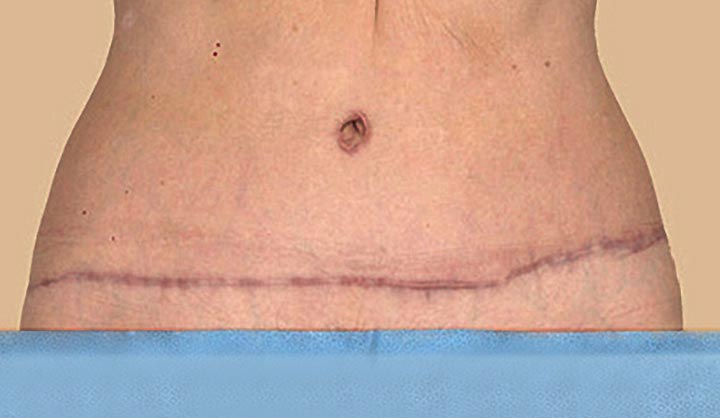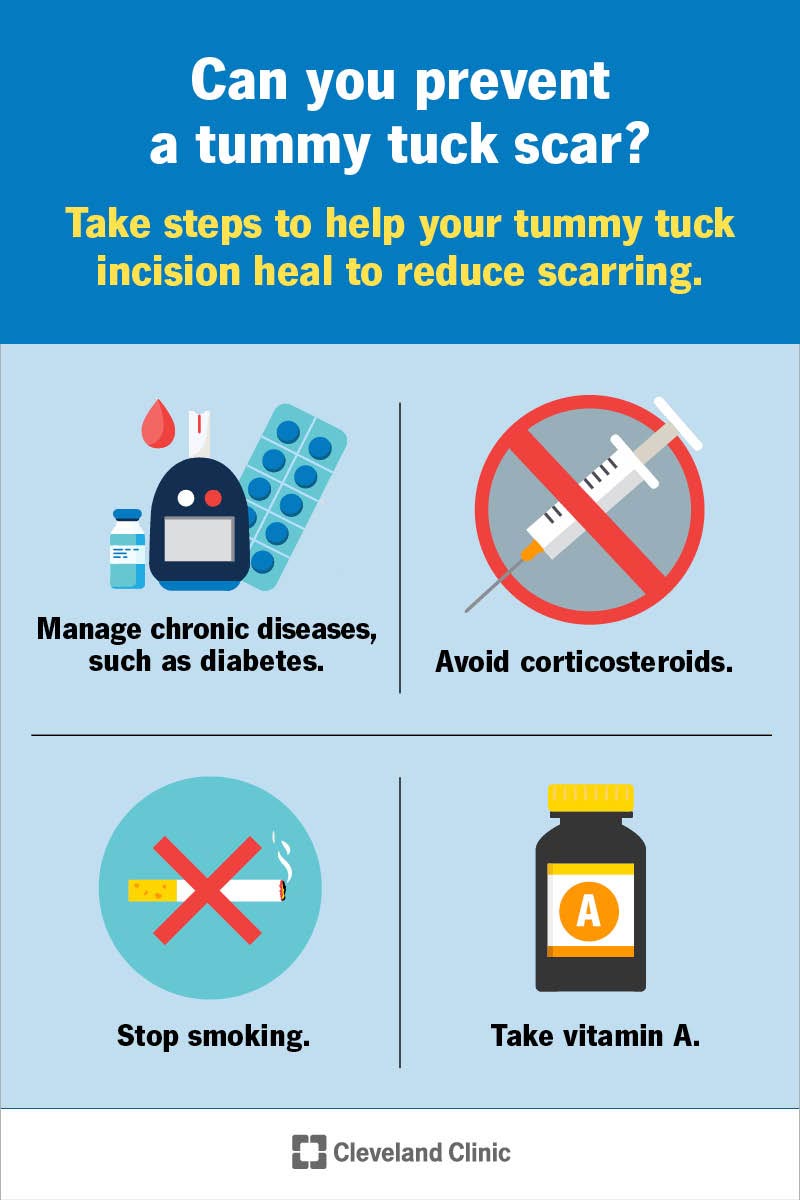After a tummy tuck (abdominoplasty), it’s normal to have one or more scars on your belly. Certain treatments, ranging from skin ointments to scar revision surgery, can reduce the appearance of a tummy tuck scar.
Advertisement
Cleveland Clinic is a non-profit academic medical center. Advertising on our site helps support our mission. We do not endorse non-Cleveland Clinic products or services. Policy

A tummy tuck scar forms in the areas where your skin heals after tummy tuck surgery. A tummy tuck (abdominoplasty) removes excess skin and fat from your belly. The scar is usually thin. It may be raised, recessed, slightly pink or lighter than the surrounding skin.
Advertisement
Cleveland Clinic is a non-profit academic medical center. Advertising on our site helps support our mission. We do not endorse non-Cleveland Clinic products or services. Policy
The size and location of tummy tuck scars vary depending on what type of tummy tuck you have. Your surgeon will likely use special glue, tape or bandages on your incision. These surgical dressings can reduce scarring by holding the skin of the incision together and keeping it moist.
The different types of tummy tuck scars may include:
You can’t completely prevent a tummy tuck scar. But you can take steps to help the incision heal after surgery, which may reduce the appearance of the scar:
Advertisement
How to reduce tummy tuck scars.

There’s a variety of ways that you can help your incision heal after a tummy tuck, which can reduce the appearance of scars. Follow your provider’s instructions carefully about caring for and cleaning your wound. Avoid heavy lifting, strenuous exercise, sexual activity and stretching until your provider says it’s safe to do these activities (usually four to eight weeks after the procedure).
Your provider might recommend some topical treatments that you apply directly to the wound:
About 2 to 3 weeks after your surgery, you may consider scar massage. Gently massaging the scar and the surrounding skin can increase blood flow to the area and help with the healing process. Massage can also break up some of the tougher scar tissue. Talk to your healthcare provider before trying scar massage.
It’s extremely important to stay out of the sun as your wound heals. Ultraviolet radiation can make your scar discolored or change its texture, making it thicker. For 12 to 18 months after your tummy tuck, wear sunscreen with an SPF (sun protection factor) of 30 if you have to be in the sun.
Getting proper nutrition is also an important part of wound healing. Talk to your healthcare provider or a registered dietitian about the best way to get all the vitamins and minerals you need. They may recommend taking a daily multivitamin or other supplements as you heal.
Steroid injections may help reduce the appearance of a thick, raised or red tummy tuck scar. Most providers reserve these injections for abnormal scarring, but providers may give steroid injections at the time of surgery or a few weeks following surgery to reduce inflammation. Others may wait a few weeks until a scar forms.
Laser skin resurfacing may reduce the appearance of a tummy tuck scar. This is another treatment usually reserved for abnormal scaring. Lasers use light or heat to stimulate the growth of new skin cells. Laser treatments may also:
Some tummy tuck scars, such as hypertrophic or keloid scars, may need surgical treatment. During scar revision, a surgeon cuts the scar out of your skin and then closes the wound with stitches. Most people need to wait 12 to 18 months after their tummy tuck for scar revision surgery. This is a time when the scar is about as good as it is going to get and the skin has had a chance to further relax and take tension off of the scar.
Advertisement
Most treatments for a tummy tuck scar don’t carry significant risks. Laser skin resurfacing can cause swelling, blistering and skin redness. Surgical scar revision may cause infection, bleeding or additional scarring.
Tummy tuck scar treatment can:
Small or fine tummy tuck scars may fade completely after about a year. However, most people will still have a visible scar.
Contact your healthcare provider if you notice your incision is:
A tummy tuck scar is a normal side effect of abdominoplasty. However, you may want to diminish the appearance of a noticeable tummy tuck scar. Taking care of your overall health and skin before surgery can help prevent severe scarring. Postoperative wound care, skin ointments, steroid injections, laser resurfacing and surgery may help improve the look of a scar after a tummy tuck.
Advertisement
Not all scars just fade away, and some are hard to hide. At Cleveland Clinic, our experts will create a personalized treatment plan for your unique scars.

Last reviewed on 08/16/2022.
Learn more about the Health Library and our editorial process.